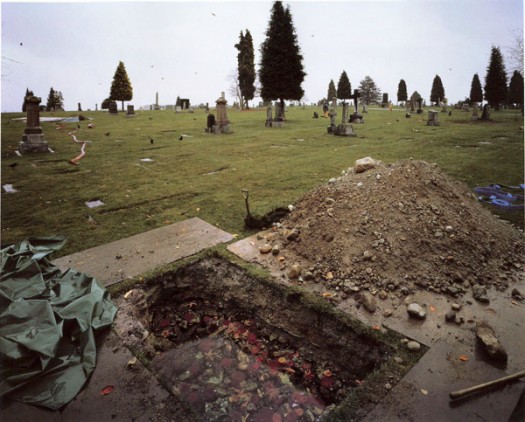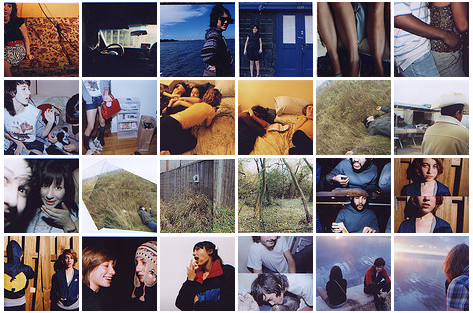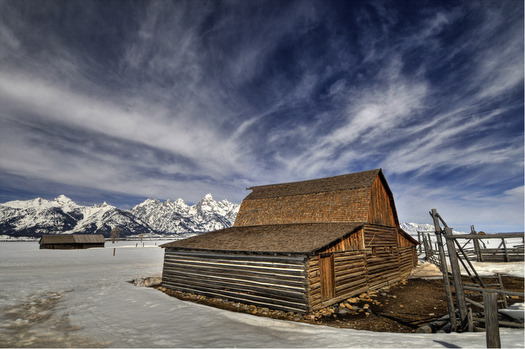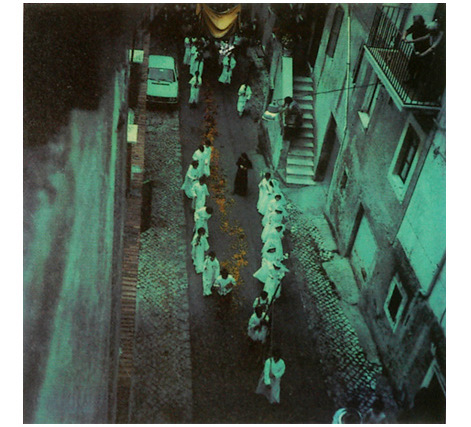It's hard to ignore the fact that Flickr promotes a distinct style of photography; I say "promotes" because Flickr's "Explore" tab displays photos that are deemed "interesting" by Flickr's "interestingness" algorithm, and the photos in this area are generally characterized by what many are now calling "Flickr style." This is shorthand for "extensively post-processed" — color-corrected, cropped, montaged, and so on — techniques that turn simple pastoral landscapes into vivid, science-fantasy dreamscapes like the example below.
I don't patently dislike post-processing, but I find that the photos deemed "interesting" frequently have a creepy unreality about them, a flatness, an obsessive visual "perfection." The result is that many of these photos seem like scenes from Dune, or Lewis Carroll, or a Bjork video, or a Thomas Kinkade landscape. Everything is in focus, perfectly lit, tightly composed. In short, I dislike "interestingness" because it feels like a sort of Pixar-ization of photography. (I love Pixar). But I don't like that CG-esque feel creeping into a medium that, for me, derives its essence from its simplicity and imperfection.
Don't get me wrong, I'm down with post-processing and unreality
I just appreciate when post-processing supports the natural aspects of the photo, when it adds layers to the scene. The photo below is called "The Flooded Grave," and the photographer is Jeff Wall. It's a montage of 75 separate photographs from two separate graveyards and Wall's studio. Why all the cutting, pasting and blending? Well, If you look closely, you'll see that there's actually a small coral reef growing at the bottom of the grave.
 Wall says, "I worked with oceanographers to create a momentary fragment of a real undersea corner. I didn't want an aquarium display, a cross-section of sea-life from the area, or anything like that. I wanted it to be a snapshot of everyday life at a certain depth of sea water." Read more at the Tate Modern's online catalog.
Wall says, "I worked with oceanographers to create a momentary fragment of a real undersea corner. I didn't want an aquarium display, a cross-section of sea-life from the area, or anything like that. I wanted it to be a snapshot of everyday life at a certain depth of sea water." Read more at the Tate Modern's online catalog.
So where does the Flickr style come from?
I've been excited to talk about Virginia Heffernan's article in last week's New York Times, Sepia No More. She addresses the disconcerting popularity of high-dynamic range cheesiness in the Flickr style, and she strikes at the heart of what is emerging as a formula for popularity on Flickr. She discusses Rebekka Gudleifsdóttir, one of the Flickr style's "leading proponents:"
[Gudleifsdóttir] discovered … how to create images that would look good shrunk, in "thumbnail†form; and how to flirt with the site's visitors in the comments area to keep them coming back. As perhaps is always the case with artists, Gudleifsdottir's evolution as a photographer was bound up in the evolution of her modus operandi, a way of navigating the institutions and social systems that might gain her a following and a living.
Creating images that look good shrunk
I'm intrigued by the interpretation of the UI's effect on the Flickr style, i.e. that the Flickr interface for browsing thumbnails informs the way in which people compose and upload photos. It makes sense to me. The browsing mechanism is tightly-tiled matrix, so photographers are going to want to craft individual elements that look good when they're (a) cropped to be square, (b) shrunk down small, and © snugly packed together.
 Here's an example from a photographer I like, a nicely differentiated matrix with some intriguing juxtapositions. Photos: Feedbacklove.
Here's an example from a photographer I like, a nicely differentiated matrix with some intriguing juxtapositions. Photos: Feedbacklove.
Is "Flickr style" a self-fulfilling prophecy?
Maybe the early users and founders were graphic designers? Maybe they really liked glossy, vivid stuff that often looks like the background of beer billboards? Whatever it is, I feel like the "Flickr style" is much less free-form than most may think. The formula behind "interestingness," as stated on the site: "Where the clickthroughs are coming from; who comments on it and when; who marks it as a favorite; its tags and many more things which are constantly changing." Interestingness as a function of the community actions makes sense. Tagging, assigning photos to groups, favoriting, commenting — all of these things seem like useful vehicles. But my sense is that everything that's being folded into "interestingness" is coming from a fairly closed system, a group of like-minded people with similar tastes promoting the same stuff again and again. Back and forth, forever. ))>((
Un-interestingness
I've got a list of my own "un-interesting" photographers, mostly gleaned from the group I Shoot Film. I also follow the feeds of a few Flickr photographers — This Is a Wakeup Call, Feedbacklove, and Last Leaf, to name a few. Still, it seems like most interesting stuff still lives outside of Flickr. I look at SUCKAPANTS and The Constant Siege pretty often, both of which can be NSFW, by the way.

 "Everyone was there. America came out to mourn." Photos: Paul Fusco/Magnum Photos
"Everyone was there. America came out to mourn." Photos: Paul Fusco/Magnum Photos This was in
This was in  Wall says, "I worked with oceanographers to create a momentary fragment of a real undersea corner. I didn't want an aquarium display, a cross-section of sea-life from the area, or anything like that. I wanted it to be a snapshot of everyday life at a certain depth of sea water."
Wall says, "I worked with oceanographers to create a momentary fragment of a real undersea corner. I didn't want an aquarium display, a cross-section of sea-life from the area, or anything like that. I wanted it to be a snapshot of everyday life at a certain depth of sea water." 
